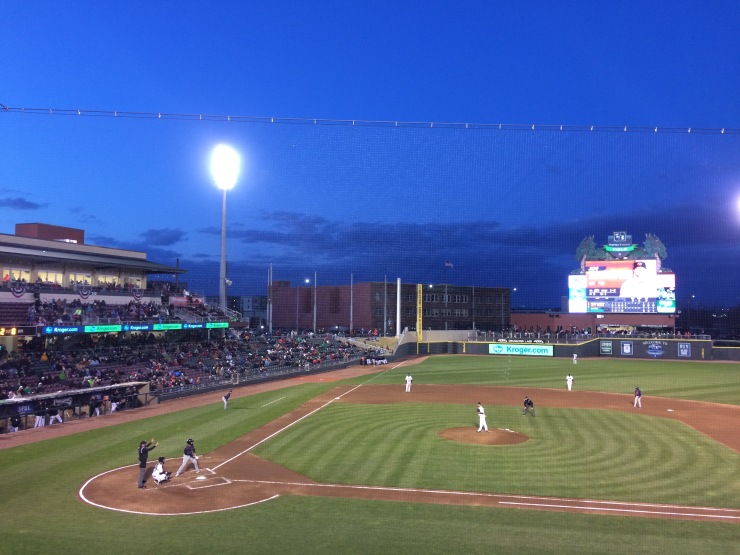The Rustbelt may have taken an overall economic hit since the turn of the millennium, but the ballpark renaissance graced the region wonderfully in the same time frame.
Continuing my now seven-year streak, I visited another MLB field for the first time in 2017–Comerica Park in Detroit. I traveled up to the Motor City with my friends Chris and Peter before the fall semester kicked off in August.
Comerica Park opened in 2000 and has much appeal with its green aesthetics, fan amenities and downtown location. But some seating features draw it back. Here are the highlights:
1) The park’s main entrance pops with grisly statues of tigers that would make Aslan jealous. Aside from the big A hats in Anaheim, it may be the most iconic ballpark entrance.
2) Batters’ eyes may be the most under-emphasized ballpark feature in my book, and the Tigers did theirs well. The field-facing side of the wall is adorned with ivy and topped with fountains and a mounted GM vehicle. Behind the wall on the concourse are statues of Tiger greats, leaving the walk captivating for fans even when the field is out of view.
3) I didn’t get a chance to sample much food at Comerica Park, but I did take advantage of a gourmet french fry stand in the Big Cat Court on the 100 level. That experience went about as you’d expect: my eyes popped as I got really excited to intake way too many flavors packed on top of a bowl of french fries, thoroughly enjoyed my first few bites, then began forcing down the second half of it because I spent way too much money to waste any food, and finally spent the rest of the game trying to calculated how many miles I’d have to run to work off all the fats and carbs now attempting to digest in my revenge-seeking stomach.
 But that’s not the park’s fault. The open-air food court, on the contrary, is a great asset to fans. It allows you to stand in one place and compare your options and prices without having to trek around the entire concourse just to understand the variety of offerings.
But that’s not the park’s fault. The open-air food court, on the contrary, is a great asset to fans. It allows you to stand in one place and compare your options and prices without having to trek around the entire concourse just to understand the variety of offerings.
4) The main drawback of Comerica Park is that it’s not built as steeply as many of the confined parks built in the same era. Our tickets were in the 300 level down the left field line and I felt farther removed from the action than I have ever felt at a Major League game. You get what you pay for, and those were the cheapest seats, but similar tickets at Nationals Park (or most other parks) would merit a much better view of the action.
5) I must say, though, building such a wide stadium in downtown Detroit is impressive. Comerica Park is right next door to Ford Field (home of the Detroit Lions) and the Fox Theater. It’s just a few blocks off of I-75 and is easily accessible.
Crunching all my subjective reasoning together, it’s my sixth-favorite park that I’ve visited, pushing Minute Maid Park to seventh. For the rest of my rankings, check out this post.

Now, three hours south on I-75 is the beautiful Dayton, Ohio. I profiled the Dayton Dragons’ Fifth Third Field in this feature last year, and I was lucky enough to see two games this spring.
As the Dragons organization professes, their main secret to success is affordable family entertainment. They host quirky on-field games almost every inning. And some, like the “Savannah Stampede,” which featured racing babies dressed in animal onsies that seemed to border all-too-closely on child slavery, get the crowd more roaring than for any baseball action.
Fifth Third Field also opened in 2000, and was one of the first dominoes to fall in Dayton’s revitalization. New ballparks get bad reputations in cities (and many times rightly-so) for promising the creation of jobs and economic boosts, but it seems to have actually worked in Dayton. The park created a real social scene downtown and brought life back to bars and restaurants. New eateries and apartment buildings have been going up in the recent years.
Today, between the park, the Schuster Performing Arts Center, and a sparkling new library all within blocks of each other, downtown Dayton looks less like the Rustbelt and more like the renderings of what other Rustbelt cities want to be in the coming years.
If you’re unfamiliar with the concept of the ballpark renaissance, I highly recommend checking out this episode of 99% Invisible about the design and influence of Oriole Park at Camden Yards.